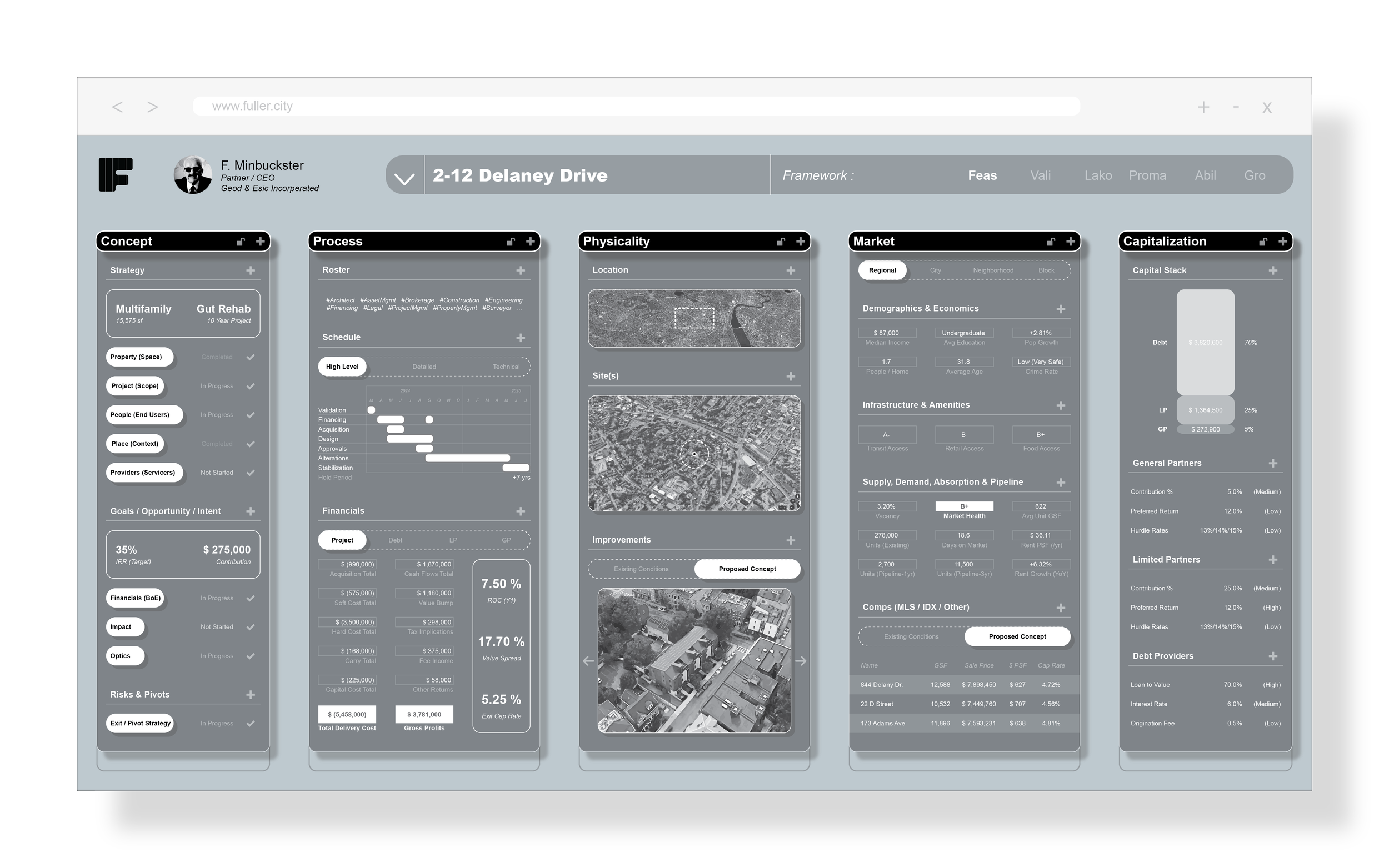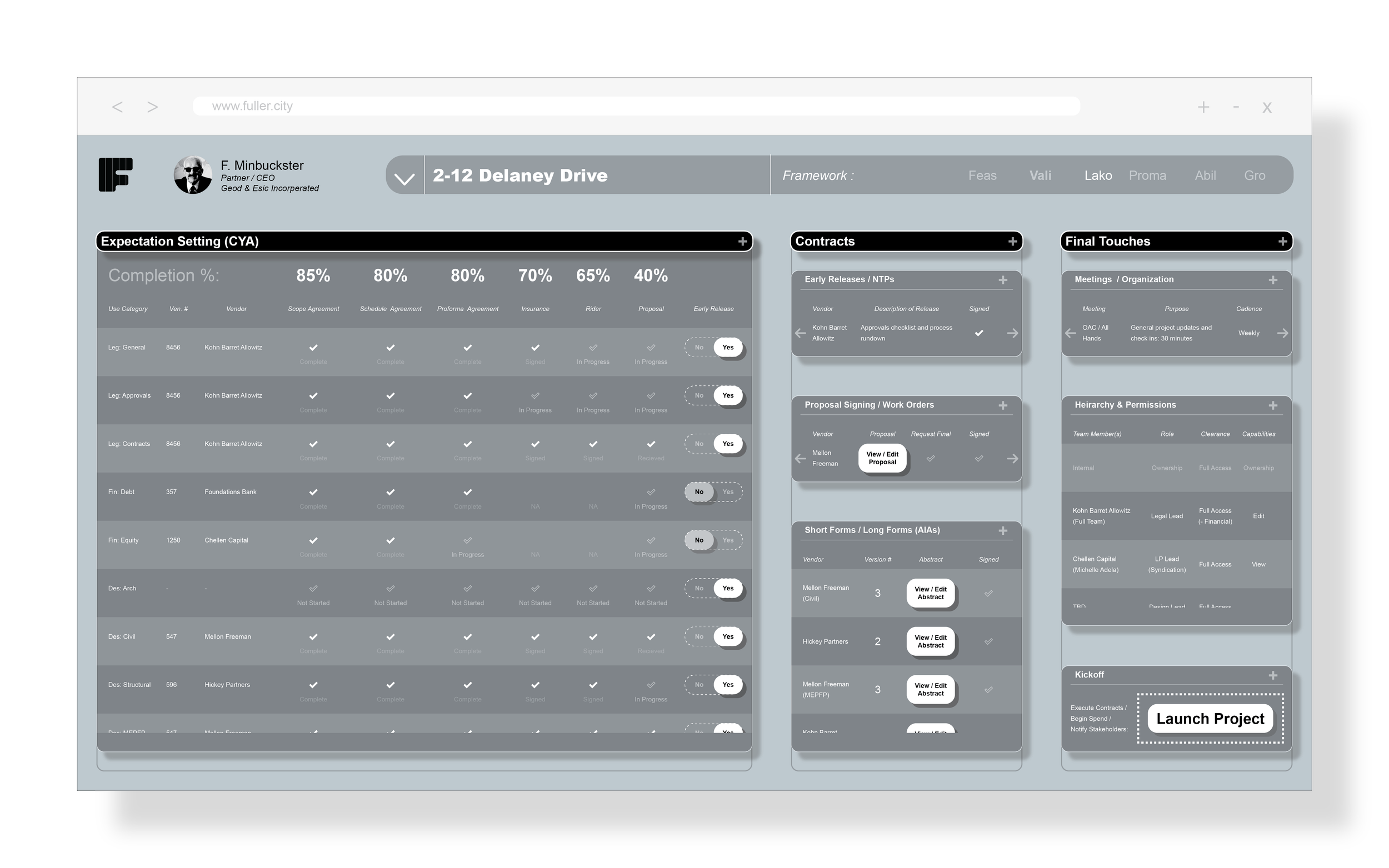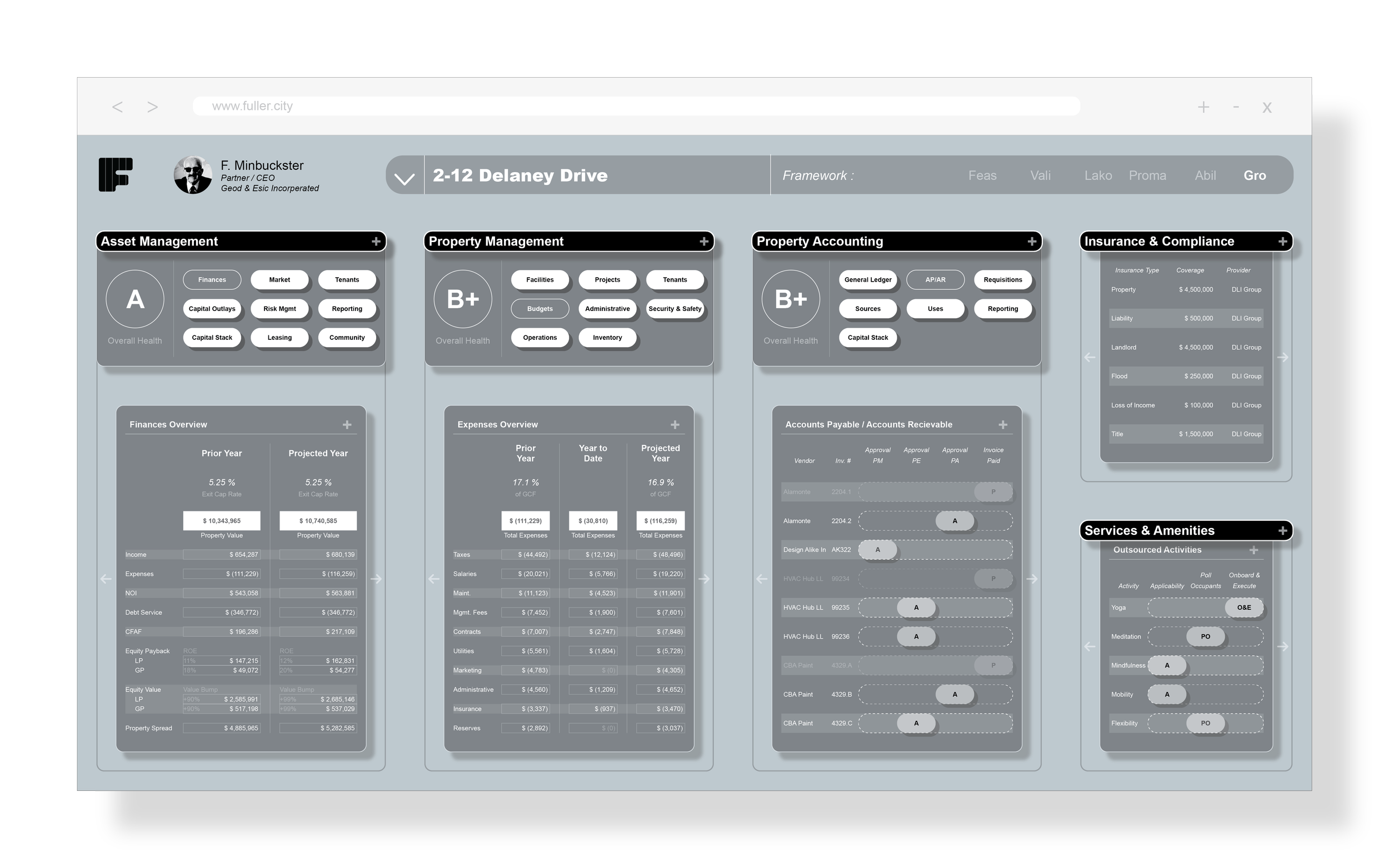“Framework”
Developers,
Owner's Project Managers,
Architects,
Engineers,
General Contractors,
Brokers,
Asset Managers,
Property Managers,
Capital Markets Groups,
Consultants & Advisors,
Developers, Owner's Project Managers, Architects, Engineers, General Contractors, Brokers, Asset Managers, Property Managers, Capital Markets Groups, Consultants & Advisors,
Project
Technology:
Concept Feasibility /
Assumption Validation /
Launch & Kickoff /
Project Execution /
Stabilization /
Growth & Optimization
“Feas”
Feasibility Tools
-
Define the high-level details of your project, setting the foundation for all subsequent phases. Shape objectives, scope, and key metrics that seamlessly integrate across the platform. Ensure alignment from concept to completion with a clear, centralized project vision.
-
Define every aspect of your project with tools for scope development, scheduling, financial proformas, and team organization. Align budgets, timelines, and responsibilities to ensure efficientexecution. Centralize all key project elements in one place for seamless collaboration and oversight from the jump.
-
Visualize your project’s location, context, and existing conditions while outlining conceptual improvements. Assess site-specific factors, environmental influences, and surrounding infrastructure to inform strategy. Create a clear foundation for planning with integrated spatial and contextual insights.
-
Analyze market conditions with insights into supply, demand, pricing, and competitive landscape for your project. Assess local trends, economic indicators, and demographic data to inform strategic decisions. Align your development goals with real-time market dynamics for optimized outcomes.
-
Structure your project’s funding by defining sources for each use outlined in the proforma. Build a balanced capital stack with GP equity, LP investments, and debt financing, tailored to project needs. Optimize financial strategy with clear visibility into contributions, allocations, and funding gaps.
“Vali”
Validation Tools
-
Ensure project feasibility by validating scope and schedule against stakeholder expertise and real-world constraints. Align expectations across teams with professional input on timelines, budgets, and execution strategies. Identify risks early and refine project plans for a realistic, achievable outcome.
-
Evaluate project risk by modeling financial and operational scenarios based on changing variables. Test the impact of market shifts, cost fluctuations, and timeline adjustments on overall feasibility. Optimize decision-making with data-driven insights that enhance resilience and profitability.
-
Choose the optimal construction approach—Design-Bid-Build, Design-Build, CM at Risk, Multi-Prime, or IPD—based on project goals and constraints. Compare methods to balance cost, risk, and schedule efficiency. Ensure seamless execution with a delivery strategy tailored to project complexity and stakeholder needs.
-
Streamline team selection with tools for RFQs, RFPs, proposal evaluations, and interviews. Compare candidates, level proposals, and select the best-fit team based on expertise, cost, and project needs. Ensure a competitive, transparent process to build a high-performing project team.
-
Visualize your full project roster with a dynamic overview of team roles, responsibilities, and relationships. Track selections, align expertise with project needs, and ensure balanced collaboration. Build a structured, high-performing team with clear oversight from planning to execution.
“Lako”
Launch & Kick Off Tools
-
Ensure all stakeholders align on scope, schedule, and budget while meeting compliance requirements, including insurance, signed riders, and conforming proposals. Establish accountability and transparency to reduce risk and streamline execution. Project managers assess early release eligibility based on past firm performance, allowing for a smoother transition into project mobilization and kickoff.
-
Finalize project agreements by consolidating all expectations, approvals, and compliance documents into formal contracts. Stakeholders execute work orders, short-form agreements, or long-form contracts to establish clear obligations and risk protections. This ensures a legally binding foundation for execution, aligning all parties before project mobilization begins.
-
Once contracts are signed, stakeholders gain access to project organization tools, including recurring meeting schedules, billing details, and team rosters. Permissions are assigned for private, view, or control access, ensuring secure and structured collaboration. With all setup tasks completed, the ‘Launch Project’ button finalizes onboarding and kicks off execution.
“Proma”
Project Execution Tools
-
Monitor project performance with real-time tracking of scope, schedule, financial proforma, and market conditions. Identify risks early with dynamic insights into budget variances, timeline shifts, and external market factors. Maintain alignment and optimize decision-making with a comprehensive health dashboard.
-
Track the project’s overall timeline with clear phase-based milestones, start dates, and completion targets. Keep the entire team aligned with simple, visual progress updates that ensure accountability. Streamline coordination by monitoring key phases and adjusting timelines as needed for on-time delivery.
-
Manage project timelines with an open-source Gantt chart that breaks down each phase into detailed tasks. Team members can click into specific segments for deeper insights, dependencies, and status updates. Stay on track with real-time adjustments, progress tracking, and seamless collaboration across all stakeholders.
-
Track overall project scope, tasks, and deliverables while assigning clear team responsibilities. Enable discussions, forums, and real-time collaboration on key topics, RFIs, and change orders. Maintain transparency and alignment with an interactive hub for managing scope-related updates and decisions.
-
Manage project budgets, commitments, and financial exposures with interactive, category-based tracking. Monitor real-time cost updates, forecast variances, and ensure financial alignment across all phases. Gain transparency and control with dynamic budgeting tools that support data-driven decision-making.
“Abil”
Stabilization Tools
-
Track content creation, marketing channels, social media engagement, and overall campaign traction in one centralized hub. Monitor performance metrics, optimize outreach strategies, and ensure alignment with leasing and sales goals. Gain real-time insights to drive visibility and maximize project exposure.
-
Track the project’s overall timeline with clear phase-based milestones, start dates, and completion targets. Keep the entire team aligned with simple, visual progress updates that ensure accountability. Streamline coordination by monitoring key phases and adjusting timelines as needed for on-time delivery.
-
Manage initial commissioning, system integrations, and operational setup to ensure a smooth transition post-construction. Oversee inspections, finalize utilities, and establish property management protocols for long-term success. Streamline onboarding with structured workflows that prepare assets for occupancy and full functionality.
-
Seamlessly integrate asset management, property management, facilities staff, accounting teams, brokerage, and external partners into project operations. Assign roles, grant system access, and establish workflows for smooth collaboration. Ensure all stakeholders are equipped with the tools and information needed for efficient long-term management.
-
Facilitate the official handover of each unit to end users with a structured turnover process managed by operations staff. Track final inspections, documentation, and key exchanges to ensure a seamless transition. Maintain quality control and customer satisfaction with a streamlined, transparent closing process.
“Gro”
Growth & Optimization Tools
-
Optimize property performance with a centralized hub for financials, market analysis, tenant relations, and capital planning. Track leasing, risk management, capital stacks, and community engagement to maximize asset value. Gain real-time insights with integrated reporting and data-driven decision-making tools.
-
Manage all aspects of property operations, from facilities and tenant relations to budgeting and security. Oversee maintenance projects, administrative workflows, safety protocols, and inventory in one streamlined platform. Ensure smooth day-to-day operations with real-time tracking and automated management tools.
-
Centralize financial management with tools for general ledgers, AP/AR, requisitions, and capital stack tracking. Monitor sources and uses of funds, generate detailed reports, and ensure financial transparency. Streamline budgeting and compliance to optimize property performance and profitability.
-
Manage insurance documents, coverage details, and compliance requirements in one centralized hub. Track regulatory obligations, safety protocols, and risk management measures to ensure full adherence. Automate renewals, monitor policy changes, and maintain up-to-date records for seamless compliance.
-
Enhance tenant and community experience by managing outsourced services and amenities in one platform. Coordinate maintenance, hospitality, and lifestyle offerings to improve convenience and engagement. Streamline vendor management, scheduling, and service requests for seamless operations.








